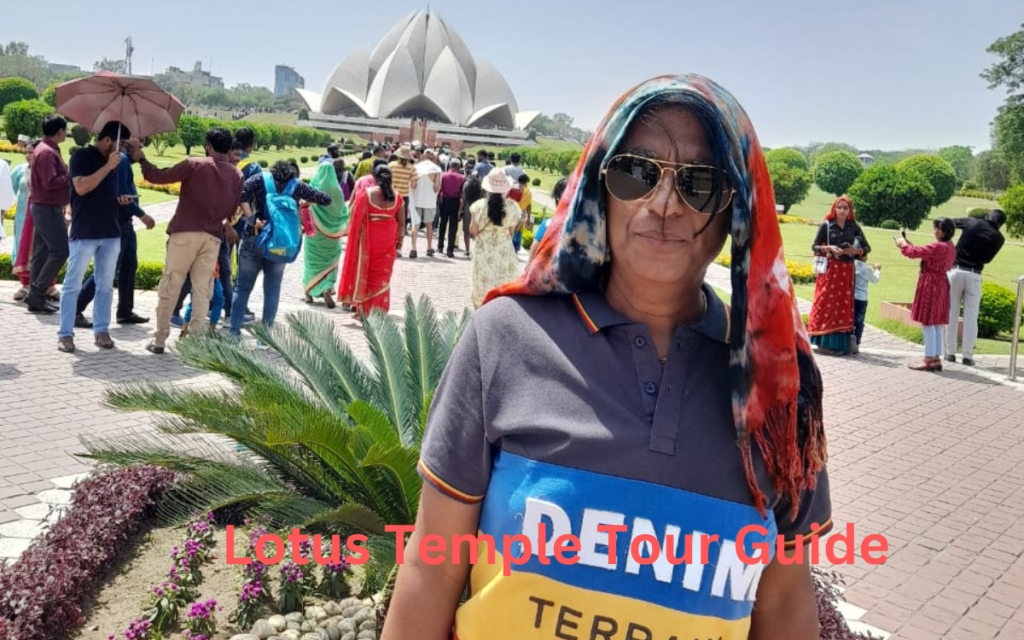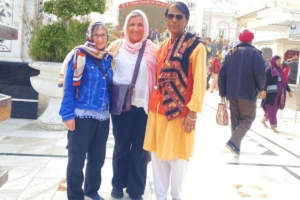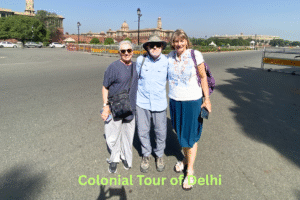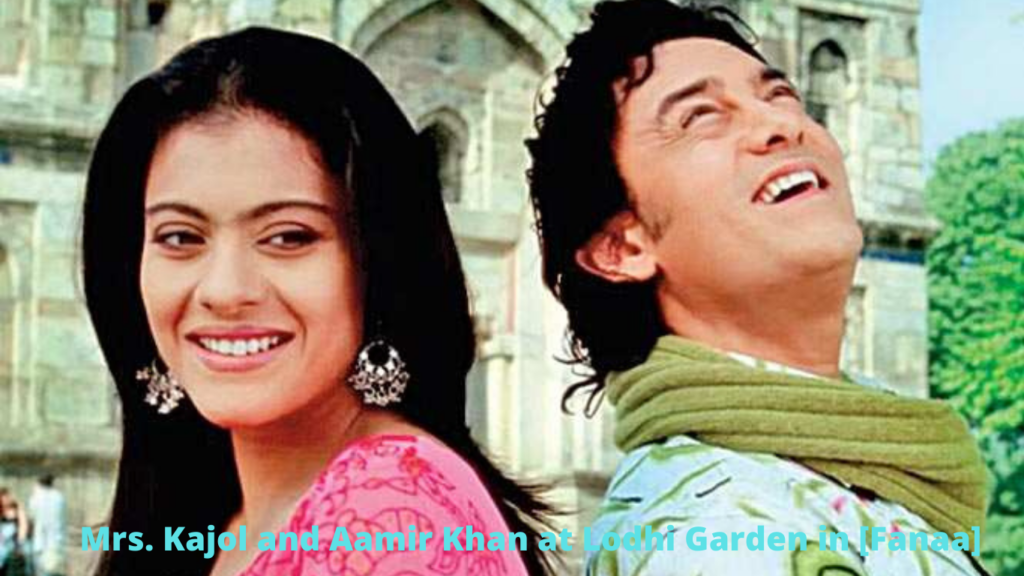The Lotus Temple Delhi history architecture guide is your complete journey into one of India’s most iconic modern landmarks. The Lotus Temple, also known as the Baháʼí Temple, is a spectacular architectural wonder in Delhi with a rich history. As a place of worship for the Baháʼí Faith, it’s open to all and provides a serene environment with its lotus-shaped structure and beautifully landscaped gardens. The temple has 27 free-standing marble “petals” forming nine sides, with nine entrance gates leading to a central hall that can accommodate up to 2,500 people at a time. Whether you are a curious traveler, a history enthusiast, or an architecture lover, you will find comprehensive information on the Lotus Temple’s history, architecture, how to reach, and timings in this guide.

Delhi Tour Guide: Best Old & New Delhi Tours
History of the Lotus Temple in Delhi
As part of our in-depth Lotus Temple Delhi architecture information guide, let’s explore its history. The temple was completed in 1986 and is one of the seven Baháʼí Houses of Worship worldwide. The Baháʼí Faith emphasizes equality, unity, and peace, making the Lotus Temple in Delhi open to all, regardless of religion or caste.
Designed by Iranian architect Fariborz Sahba, the temple was funded through the donation of Ardashir Rustampour, a Baháʼí devotee from Hyderabad, Pakistan, who gave his entire life savings to buy the land in Delhi. Today, the temple stands as a beacon of faith and inclusion, welcoming over 10,000 visitors daily.
Lotus Temple Delhi Tour Guide: Experience the Soul of the City
A knowledgeable Lotus Temple Delhi tour guide can make your visit far more enriching. Guides help you understand the symbolism behind the structure, the principles of the Baháʼí faith, and lesser-known stories about the site’s creation. They also assist in navigating nearby attractions like Kalkaji Temple, ISKCON Temple, and Nehru Place market.
Whether you’re taking a private guided tour or joining a Delhi sightseeing package, adding the Lotus Temple with a guide offers deeper insights and a more meaningful connection to the place.
Lotus Temple Delhi Architecture Information: A Marvel of Modern Spiritual Design

The Lotus Temple in Delhi, also known as the Bahai Lotus Temple or Kamal Mandir, is one of the most stunning architectural landmarks in India. Recognized globally for its unique design, the temple resembles a white lotus flower, symbolizing peace, purity, and spiritual awakening. If you’re searching for detailed and fascinating Lotus Temple Delhi Architecture Information, you’re in the right place.
Designed by Iranian architect Fariborz Sahba, the Lotus Temple structure was completed in 1986 and immediately gained international attention. The temple is built using white Greek marble, and features 27 free-standing petals arranged in clusters of three to form nine sides, creating a harmonious and symmetrical shape. These petals are the strong pillars of the building and support the entire weight of this stunning sanctuary.
One of the most interesting Lotus Temple facts is its inclusive design — the temple is open to people of all religions, castes, and backgrounds, embodying the teachings of the Baháʼí Faith. With nine gates leading to a central prayer hall that can seat up to 2,500 people, the temple offers a calm and welcoming environment for meditation and silence.
What makes the architecture of Lotus Temple even more fascinating is its eco-conscious design. The nine water ponds surrounding the temple are not only ornamental — they help regulate the temperature inside the hall through a natural ventilation system. This smart engineering allows the space to remain cool and serene, even in the peak summer heat of Delhi.
The interior hall is designed in such a way that natural light filters through the inner folds of the marble petals, eliminating the need for artificial lighting during the day. This brilliant use of skylight architecture adds to the temple’s calm and ethereal ambiance.
Spread across 26 acres of lush gardens and walkways, the Lotus Temple is one of the most famous places to visit in Delhi. Constructed at a cost of 10 million dollars, the land for the temple was bought using the life savings of Ardashir Rustampour, a devoted Baháʼí follower from Hyderabad, Sindh (now in Pakistan).
Over the years, the Bahai Lotus Temple has received several international architectural awards and has been featured in countless magazines and travel books. It’s not just a place of worship — it’s a global icon and a must-visit Delhi tourist attraction that continues to inspire millions.
Also See Famous Temples in Delhi
Lotus Temple Why Lotus Flower? (Kamal ka Mandir)
When discussing the Lotus Temple Delhi Architecture Information – History, Design & Structure Guide, one must understand the deep symbolic meaning behind its unique lotus-shaped design. The Lotus Temple, also known as the Bahai Temple, has gained global prominence since its inception for its striking and symbolic architectural structure. The International Bahá’í Faith Community adopted the lotus as a central element in the design of this remarkable temple in New Delhi, India, recognizing its spiritual and cultural significance across multiple religions.

The lotus flower has long been a symbol of purity and spiritual elevation. In Buddhism, it represents purity of the body, speech, and mind—rising gracefully above muddy waters, untouched by impurity. According to traditional Buddhist biographies, lotus flowers are said to have appeared under the Buddha’s first seven steps, and lotus thrones are a common motif in sacred Buddhist art.
In Hinduism, the lotus is no less revered. Deities such as Lakshmi, Brahma, Saraswati, and Kubera are often depicted sitting upon lotus thrones. The god Vishnu is described as Padmanabha, meaning “lotus-naveled,” with the lotus blooming from his navel to create Brahma. This majestic flower, symbolic of divine beauty and spiritual awakening, deeply influenced the architecture of the Lotus Temple.
Through this Lotus Temple Delhi Architecture Information – History, Design & Structure Guide, you can see how the lotus flower transcends visual beauty—it embodies the sacred philosophies of multiple faiths, making the temple not just a modern marvel, but a universal symbol of peace, unity, and spiritual ascent.
Also Visit: Sri 108 feet Bade Hanuman Ji ka Temple in Delhi.
Lotus Temple Delhi Best Time to Visit

The Lotus Temple welcomes over 4.5 million visitors annually, making it one of the most visited landmarks in the world. As you walk through its grand entrance and peaceful gardens, a sense of calm washes over you. The best time to visit the Lotus Temple is during early morning or late afternoon hours, when crowds are fewer, and the temple’s serene beauty can be fully appreciated.
Inside, you’re invited to practice silent meditation, chant sacred mantras of any faith, or simply sit in peaceful reflection. The temple’s tranquil environment and breathtaking Bahai-inspired lotus architecture offer a unique spiritual retreat. Whether you’re drawn by faith, architecture, or inner peace, the Lotus Temple is a must-visit in Delhi.
Lotus Temple Delhi inside Prayer Hall
The lotus flower holds great significance in Hindu mythology and is revered alongside many deities. Hindus worship the goddess Lakshmi along with Vishnu, who is often depicted on a delicate pink lotus in iconography. Interestingly, several other deities such as Brahma, Sarasvati, Lakshmi, and Kubera are also seated on stylized lotus thrones in Hindu traditions. This majestic flower is so deeply rooted in Hindu culture that even the mighty god Vishnu is represented as “Padmanabha” or lotus-navel, with a lotus emerging from his navel and Brahma seated upon it.

When exploring the Lotus Temple Delhi Architecture Information – History, Design & Structure Guide, it becomes clear that the lotus flower’s spiritual symbolism played a central role in the temple’s design. The reverence of the lotus in religions like Hinduism, Buddhism, and Jainism reflects the temple’s universal message of unity, purity, and peace. The Lotus Temple beautifully blends architectural brilliance with spiritual depth.
Lotus Temple Prayer Timings
The goal of silent meditation practice is to gain insight into the true nature of reality. The name Vipassana means seeing things as they are and essentially not letting talk, noise or other forms of communication get in the way.
1. Lotus Temple /Kamal ka Mandir is a place for silent prayer and meditation for people of all religious backgrounds. So one should not make noise.
2. Prayers timings are 10:AM, 12:00PM, 3:00PM and 5:00PM for five minutes and a few prayers from different religions are chanted or read out loud. People are requested to not leave the Prayer Hall during this time, but wait until the prayers are over.

As to enter inside the Lotus Temple one has to remove his/her shoes and keep inside a bag which is available there and deposit the bag with the shoe room underneath and collect the token. Once your visit is over you collect your shoe bag from the opposite window.
Best Places to Visit in Delhi Contact: Delhi Tour Guide-Harry.
Best time to visit Lotus Temple Delhi
If you’re planning to visit the Lotus Temple, timing is everything. While the temple is a stunning piece of architecture any time of day, the best time to experience its full splendor is during the dusk and evening hours. As the sun sets and the sky transforms into a warm hue, the temple’s floodlights illuminate the lotus-shaped structure, enhancing its beauty and leaving visitors in awe, making for an even more breathtaking sight.
Photography at Lotus Temple Delhi
Photography is allowed out side but not inside the temple.
Lotus Temple Delhi Information Centre

The Information Center is built to the latest specifications and provides information on various aspects of the Baha’i Faith in the form of photo panels, written texts and films. In the center is the visitor’s gallery. The gallery focuses on the history of the Bahá’í Faith, its philosophy, and the socio-economic development activities of Bahá’ís around the world. The information center serves as a venue for ongoing discussions on topics such as gender equality, the constructive role of religion in society, and more.
The information center is open Monday through Saturday. Visiting time 9:00 AM to 5:00 PM.
Lotus Temple/ Bahai Temple Nearest Metro How to reach
Reach by Metro -Nearest Station is Kalkaji Mandir Station on Violet Line, Nehru Place Station on Magenta Line -Lotus Temple is well connected by the bus and Metro. Kalkaji bus stop is near the temple where DTC buses ply from all parts of Delhi.
Lotus Temple Delhi Timings
Timings: 09:00 AM to 07:00 PM in summer. 9:00 AM to 5:30 PM in winter. Closed on Every Mondays.
Lotus Temple Delhi Information
- Lotus Temple Built in: November 13th 1986
- Material used Greek White marble
- Lotus Temple Height 34 meters
- Lotus Temple Architect Fariborz Sahba an Iranian Architect
- Number of ponds: 9
- Number of Lotus petals 27 lotus petals
- Lotus Temple Hall Capacity: accommodates 2500 people
- Lotus Temple Located Near Kalkaji Temple, Behind Nehru Place
- Nearest Metro Station for Lotus Temple is Kalkaji Mandir
- Lotus Temple Address is Bahapur, Kalkaji, New Delhi, Delhi 110019
Final Thoughts – Lotus Temple Delhi Architecture Information
The Lotus Temple Delhi architecture information reveals how beauty, belief, and modern design can come together in one powerful form. Whether you visit for its architectural elegance, spiritual stillness, or historical richness, the Lotus Temple stands as a lasting reminder that unity is not just a belief — it’s something you can step into.
Places to visit near Lotus Temple Delhi
Lotus Temple to Qutub Minar a U.N.E.S.CO. world heritage site not be missed. 10.4 Km.
- Kalka JI Temple: The most sought after place to visit near Lotus Temple is the Kalkaji Devi Temple. One of the most popular temples not only in Delhi but in entire North India, Kalkaji Devi Temple is dedicated to Goddess Kali in the form of Goddess Kalka who was incarnated to kill the demon Raktabija. It is located opposite to the Nehru Place business centre. According to legend, the image of Goddess Kalka is self-manifested.
It is believed that this temple dates back to Satya Yuga of Hindu religion. - Astha Kunj District Park – Another place to visit near Bahai Temple is the Kalkaji District Park. A popular hangout place among locals, this park is a good place to relax after your visit to other sightseeing places. Its captivating terraced gardens and lush greenery offer a refreshing break from the concrete jungle of the city. It is popular venue for the Navratri festival as well.
- Iscon Temple: Located at Hare Krishna Hills, ISKCON (International Society for Krishna Consciousness) Temple in Delhi was opened in 1988. Designed by Achyut Kanvinde, Iskcon Temple Delhi is one of the biggest temple complexes in India. ISKCON Temple is adorned with breathtaking interiors depicting instances from various religious epics while holy chanting create peaceful and spiritual atmosphere.








